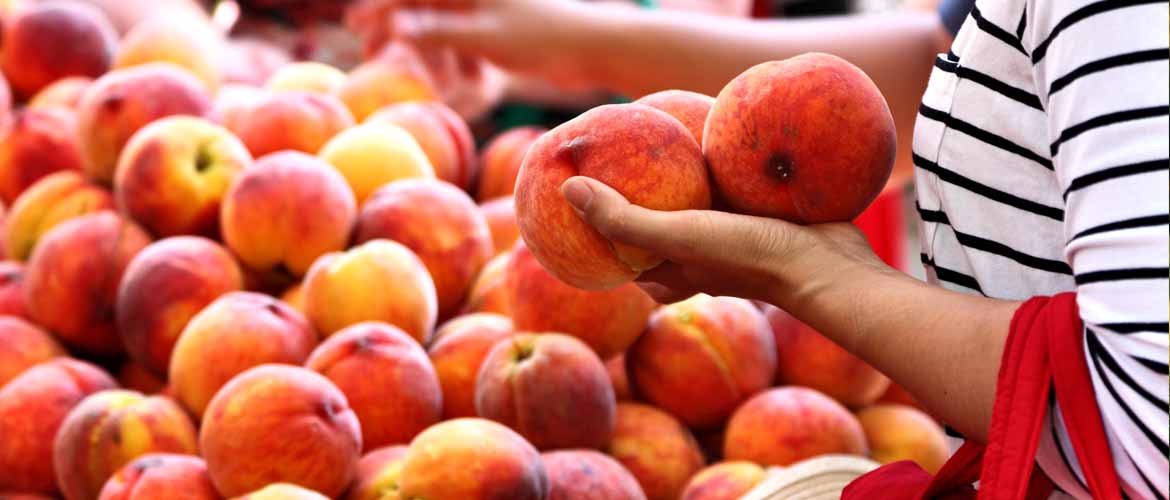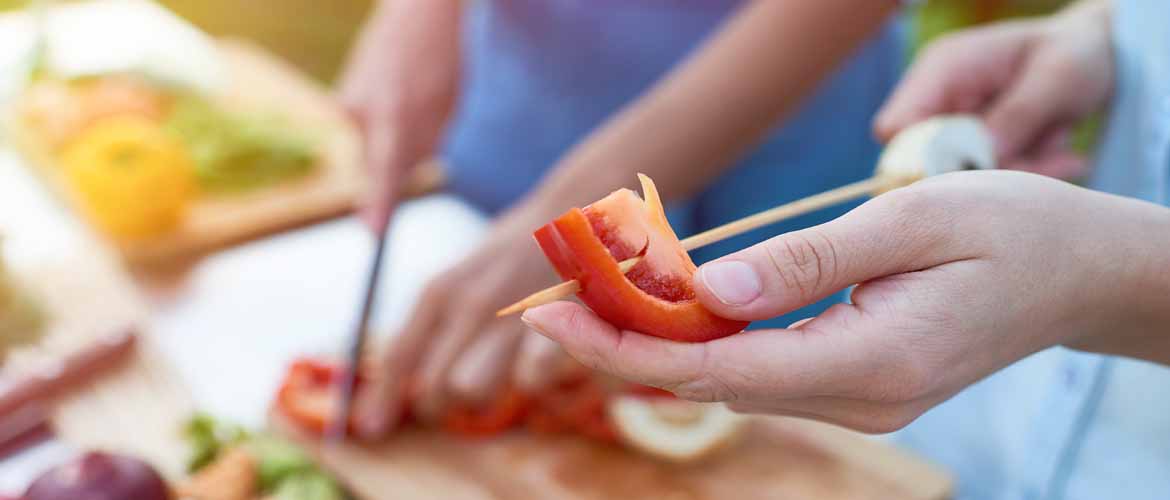August 12, 2024
What can you do to protect yourself this summer as you indulge in those fresh strawberries or hand-picked apples? When you're out and about and looking to fill your basket or grocery bags with bright green, yellow, orange, and red produce, it's important to keep a couple pieces of food safety wisdom in the back of your mind.
Food Safety Basics
Fruits and vegetables play an important role in your overall health, providing your body with the nutrients it needs to thrive. The summer season in particular is a popular time to indulge in fresh produce since it’s in season and more readily accessible, whether it's at farmers markets, grocery stores, or from your own back yard. When you're filling your basket or grocery bags, remember to be mindful of the produce you select.
The U.S. Food and Drug Administration recommends taking the first step right in the market by selecting produce that's not bruised or damaged in any way.5 Bacteria are likely to settle into those soft or moist places. And when you're purchasing pre-cut and pre-packaged produce, which could include salad greens, select ones that are refrigerated. Though it may seem like common sense, it's also recommended to keep those fresh veggies and fruits away from raw poultry, seafood, and meat while purchasing, storing, handling, or preparing them.
That being said, when you are finally home, store your fresh produce in a clean fridge. The temperature should be kept at 40 degrees or below. Though some produce can remain on your counter, remember to keep packaged or pre-cut produce in the fridge, as well as items you've cut into, peeled, or cooked.
MedExpress Pro Tip: Store your fresh fruits and veggies on the higher shelves in your refrigerator. Keep raw meats near the bottom. This also helps to prevent contamination should the raw meats spill or drip.
Safe Food Preparation
Though there are food hygiene and safety tips that have likely been instilled at a young age, always begin your preparation with clean hands, utensils, and surfaces. Then, take a look at your produce. If there happen to be any bruised or damaged areas since the time you bought them, cut them away. Discard anything that appears to be rotten. While your sink is nearby, make sure your produce is also rinsed thoroughly with running water. Some items, like cucumbers or melons, should be scrubbed with a produce brush. Pat them dry after a thorough cleaning.
If your packaged or pre-cut produce indicates on the wrapping that it's pre-washed, it's likely ready to consume. And it's also recommended to only wash your produce prior to consumption – washing and storing your produce to enjoy later will cause it to spoil faster.
MedExpress Pro Tip: Avoid cross contamination by using separate cutting boards and utensils for produce and raw meat or eggs.
Fresh Produce: To Wash, Or Not To Wash
What about the other fruits or veggies that you might consume on a regular basis that don't require "preparation?" What about the apple you have packed in your lunch, or the orange ready to be enjoyed for an evening snack?
Unfortunately, simply rubbing your fruit on your clothes won't clean it of bacteria.2
A lab study conducted by the Food Safety and Inspection Service indicated that wiping apples with paper towels showed little bacterial reduction.3 However, when washed, there was more than 95 percent reduction in bacteria. Lab results indicate that there was little difference between the washing solution – water, vinegar, lemon juice, and vegetable wash solutions heeded similar results, though they noted that it's cost effective to use running tap water.
When it comes to fresh vegetables, particularly broccoli and lettuce, the study determined that soaking and rinsing were the most effective cleaning methods. In addition to the risk for harmful germ and pathogen contamination, produce may come into contact with pesticides in its earliest days in the hands of vendors or farmers. The Centre for Science and Environment notes that about 75 to 80 percent of pesticides can be reduced just by washing produce with cold water.6 Consider these food safety tips before eating or working with produce:
- Fruits and vegetables, such as pears, plums, apples, and okra, may need two or three washings because you also eat the skin.
- Softer produce including peaches and tomatoes, may take a bit more care to wash.
- Grapes and berries are best washed in a colander under running water.
- Leafy greens can be cleaned by removing the outer layers before rinsing individual leaves or soaking them.
And just because your favorite citrus fruit or melon has an outer skin or rind, doesn't mean it's off the hook. Wash the rind before cutting or peeling the fruit, as you never know what bacteria or pathogens have touched the outer layer, and could transfer to the fruit inside. Same goes for veggies that are best enjoyed peeled, like carrots, potatoes and zucchini. Thoroughly wash the outer skin before peeling and consuming these tasty vegetables.
What is a Foodborne Illness?
Foodborne illnesses, like salmonella, impact thousands of people every year. The CDC tells us that each year in the United States, there are about 9.4 million foodborne illnesses, resulting in 55,961 hospitalizations.1 Among those diagnoses, the CDC notes that there are 31 known pathogens (bacteria or viruses that can cause disease), which can cause foodborne illnesses. Some of the most foodborne illnesses are:
- norovirus
- salmonella
- clostiridium perfringens
- campylobacter spp.
- staphylococcus aureus
Other pathogens like listeria and E. coli are leaders in illnesses resulting in hospitalization or death.
In general, pathogens often pass from the water or dirt in which the fruits and veggies came from or later came in contact with. However, others can be contracted in the packaging, storing, or preparation stages. The CDC notes that contamination can happen at any time during the product's journey from its origin to the consumer.4 Germs could be passed on to the produce from contaminated irrigation water or unsanitary harvesting conditions in its earliest stages, or could later settle on the produce while being distributed, stored, or handled before reaching the buyer.4 Salmonella, C. perfringens, and campylobacter, for instance, come from undercooked or raw eggs, poultry, or meat. When those items come into contact with your fruits and veggies, it could spell bad news for the seemingly harmless produce, making safe food handling all the more important.
Other pathogens, like E.coli, listeria and even norovirus are thought of more commonly with fruits and vegetables. E.coli and norovirus are strands that naturally effect and contaminate the produce at their sources, while listeria may be common in produce like raw sprouts or melons as they grow in warm, moist environments.
Symptoms of foodborne illnesses are fairly common and can include:
- diarrhea
- fever
- nausea
- achiness
Certain demographics are more susceptible to foodborne illnesses because of immature or compromised immune systems, including infants and young children, the elderly, pregnant women, and those with immune system troubles.
MedExpress Pro Tip: If you're experiencing symptoms of a foodborne illness, one of the most important aspects of treatment is maintaining hydration. Most cases of foodborne illness are self-limited and will resolve without the need for antibiotics. However, the friendly team at your neighborhood MedExpress are there to evaluate your symptoms and get you back to health as soon as possible.
Originally published June 2018. Updated August 2024.
References:
1 CDC. Burden of Foodborne Illness. Last updated July 15, 2016. Accessed April 30, 2018.
2, 3 FSIS. Eating Fruits and Vegetables Fresh and Clean. Last updated in 2004. Accessed April 30, 2018.
4 CDC. How Food Gets Contaminated: The Food Production Chain. Last updated April 24, 2024. Accessed August 12, 2024.
5 FDA. Produce: Selecting and Serving it Safely. Last updated March 15, 2018. Accessed: April 30, 2018.
6 CSE. Removing Pesticides from Fruits and Vegetables. Last updated Sept. 8, 2011. Accessed April 30, 2018.




